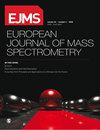电感耦合质谱法测定阿托伐他汀钙中砷、镉、汞、铅和镍等元素杂质
IF 0.8
4区 化学
Q4 PHYSICS, ATOMIC, MOLECULAR & CHEMICAL
引用次数: 0
摘要
阿托伐他汀钙被用作心血管疾病的一线治疗。根据国际协调会议(ICH)指南ICH Q3D,元素杂质可以从各种来源进入药品。这些元素杂质对最终用户没有任何治疗益处。相反,它损害了正常的生理系统。第一类元素,如砷、镉、汞和铅,是对人体有毒的无机杂质。以镍为催化剂合成了阿托伐他汀钙。它属于2a类,对人类有毒性,必须量化。建立了一种简单、快速、可靠的电感耦合等离子体质谱法,利用开放样品消解技术测定阿托伐他汀钙中砷、镉、汞、铅、镍等元素杂质,并按照ICH Q3D、USP和USP通章进行了验证。内部标准物如铟、铽、铊、铋和钇被用来校正分析过程中产生的非光谱干扰。所有的溶液中都加入了金,因为它可以通过汞的混合保存汞。每次执行系统适用性参数时,都会对系统性能进行评估。所有元素的限量根据ICH Q3D确定。对五种元素的检出限和定量限进行了估计。通过检查样品基质和其他元素的干扰,证明了方法的特异性。在样品浓度为25% ~ 200%的范围内建立了各元素的线性关系,相关系数不小于0.999。在所有元素的j值的50%、100%和150%三个峰值水平上证明了该方法的准确性。加样回收率在90 ~ 120%范围内。方法精密度在100% j值。各元素的相对标准偏差均小于5%。结果表明,新建立的电感耦合等离子体质谱法测定阿托伐他汀钙中砷、镉、汞、铅、镍等元素杂质在允许范围内,适合常规使用。本文章由计算机程序翻译,如有差异,请以英文原文为准。
Determination of arsenic, cadmium, mercury, lead and nickel as elemental impurities in atorvastatin calcium by inductively coupled mass spectrometer
Atorvastatin calcium is employed as front-line treatment for cardiovascular diseases. According to the international conference on harmonization (ICH) guideline ICH Q3D, elemental impurities can come into drug products from various sources. These elemental impurities do not have any therapeutic benefit to the end-user. On the contrary, it harms the normal physiological system. Class 1 elements like arsenic, cadmium, mercury, and lead are inorganic impurities that can cause toxic effects on the human body. Nickel was used as a catalyst during the synthesis process of atorvastatin calcium. It comes under the Class-2A, can cause toxicity to humans, and must be quantified. A simple, fast, reliable inductively coupled plasma mass spectrometric method for the estimation of elemental impurities like arsenic, cadmium, mercury, lead, and nickel in atorvastatin calcium by open sample digestion technique was developed and validated in accordance with ICH Q3D and USP < 232 > and USP <233 > general chapter. Internal standards like indium, terbium, thallium, bismuth and yttrium were used to correct the non-spectral interferences that were generated during analysis. Gold was added to all solutions as it preserves mercury by amalgamation. The system performance was evaluated every time my performing system suitability parameters. The limits for all the elements were fixed in accordance with ICH Q3D. The limit of detection and the limit of quantification for all the five elements were estimated. Method specificity was proven by checking for interferences due to the sample matrix and other elements. Linearity of each element in standards was established from 25% to 200% of sample concentration, and correlation coefficients were found to be not less than 0.999. The accuracy of the method was demonstrated at three spiking levels at 50%, 100%, and 150% of the J-value for all the elements. The recoveries for all elements at each level were within the range of 90–120%. Method precision was proved at 100% J-value. The relative standard deviation of all elements was less than 5%. It concludes that this newly developed and validated reliable inductively coupled plasma mass spectrometric method for estimating of elemental impurities like arsenic, cadmium, mercury, lead, and nickel in atorvastatin calcium was within the permitted limit and suitable for routine use.
求助全文
通过发布文献求助,成功后即可免费获取论文全文。
去求助
来源期刊
CiteScore
2.40
自引率
7.70%
发文量
16
审稿时长
>12 weeks
期刊介绍:
JMS - European Journal of Mass Spectrometry, is a peer-reviewed journal, devoted to the publication of innovative research in mass spectrometry. Articles in the journal come from proteomics, metabolomics, petroleomics and other areas developing under the umbrella of the “omic revolution”.

 求助内容:
求助内容: 应助结果提醒方式:
应助结果提醒方式:


